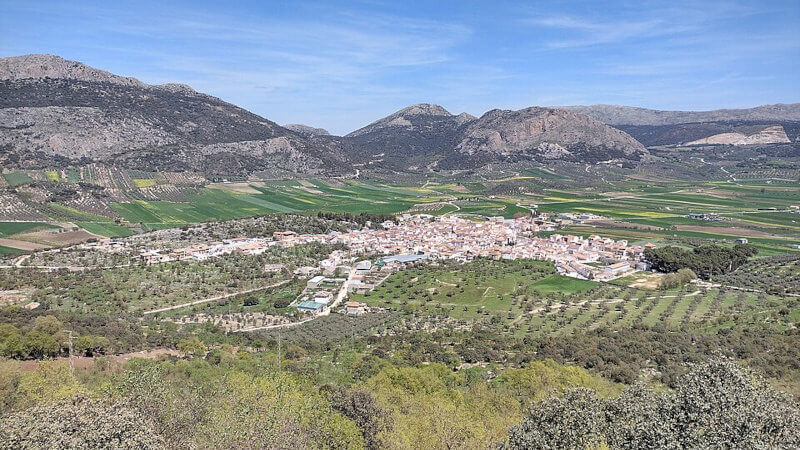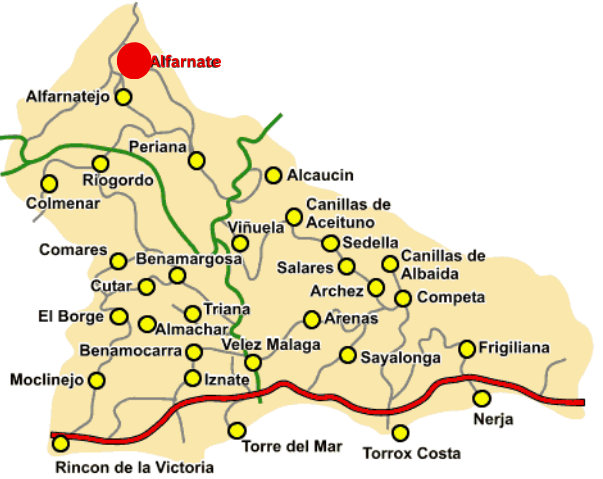-
19
Aug 2025
Alfarnate

With its 1,100 inhabitants, Alfarnate, located in the northwest of the Axarquía near the border with Granada, is one of the smaller white villages. It is the highest village in the Axarquía, with streets situated at 925 meters above sea level, but unlike most white villages, its streets are not very steep. Due to its altitude, the area is sometimes called the Pyrenees of the South, and in winter, Alfarnate and the neighboring village Alfarnatejo often have snow. The surroundings are beautiful, as Alfarnate lies in a kind of green valley surrounded by tall rocky mountain ranges.

History
The name of the village originates from the Arabic Al-farnat, which means grain mill. The valley and the rolling hills allowed for abundant cultivation of cereals and grains. Even today, there is still a lot of farming. Traditionally, the valley was probably a resting place for roaming caravans, an accessible spot where people and animals could catch their breath before crossing the next mountain range. Along the banks of the Palencan and Morales streams, which form the Sabar River south of the village, remains of the first prehistoric settlers were found. Near the mountain pass El Puerto de los Alazores, remains of flint workshops from the Neolithic era have been discovered.
In 1487, the troops of the Catholic Monarchs Ferdinand and Isabel passed through the valley on their way to reclaim Vélez. During the Spanish Civil War (1936-1939), this area was heavily affected; many fled to the coast to travel from Torre del Mar to Almeria. One of the many tragedies of the war was the massacre on the Málaga-Almeria Road where 4,000 to 6,000 Spaniards lost their lives. Several bunkers remain in the area, silent witnesses of this terrible war.
Exploring the village
The building of the Ayuntamiento (town hall) dates from the 16th century and is definitely worth a visit. This building, in Mudejar style—a Spanish architectural style combining Muslim and Christian artistic elements—used to serve as a grain warehouse.
Alfarnate has two churches: the hermitage of the patron saint La Virgen de Monsalud, also dating from the 16th century, and the white St. Ana church with its imposing, robust tower, which is the village’s main church. During the festival of La Virgen de Monsalud around September 12, this church is at its most beautiful, decorated with cloth banners, tapestries, and medieval lanterns. On the main street, Calle Secretaria, there are several 16th-century buildings, and the village also boasts three picturesque bridges.
Special is the Museo de Juguetes Antiguos, a small museum with antique tin toys.
Just outside the village lies La Venta de Alfarnate, now a restaurant but originally a 13th-century inn that provided shelter to many Spaniards passing through the valley, from kings to bandits. The latter targeted the goods of traveling merchants who stopped here.
Festivals/Ferias
As in many villages in the Axarquía, Día de La Candelaria is celebrated here on February 2. The festival takes place 40 days after Christmas, the day when Joseph and Mary presented Jesus at the temple, and La Virgen de la Candelaria is also honored. In Alfarnate, bundles of broom branches are set on fire and dragged through the streets by the youth. The celebration ends with a large bonfire on the central square where villagers dance and sing.
La Romería de San Marcos is celebrated on April 25 on a plain near Puerto de los Alazores. Villagers enjoy a day in the countryside with food (the traditional hornazo con choto, pastry, and roasted goat) and drinks. In the evening, there is a procession in which the image of La Virgen de Monsalud is carried from her hermitage to the St. Ana church.
Around May 15, San Isidro is celebrated, another holiday with a romería during which the patron saint is carried outside the village. Agriculture remains very important for Alfarnate, and this festival in honor of the son of a farmer is celebrated exuberantly.
The third weekend in June is El día de la Cereza (Cherry Day). Alfarnate is especially known for the origin of delicious, large, juicy cherries. The altitude and flat valley land provide excellent conditions for cherry orchards, and every year 70,000 to 80,000 kilos of cherries are harvested. You can imagine how beautiful it looks when all the trees are in bloom! This celebration is a culinary festival where visitors can taste cherries as well as many other local delicacies.
Fiesta de la Virgen de Monsalud is celebrated around September 12. For four days, you feel transported back to a medieval village, where villagers dress in costumes from that era and reenact scenes from the battle between Moors and Christians, with the image of the Virgen as the focal point. During this festival, there is a market in the village with many stalls selling artisanal crafts and local products from the land, such as wine, cheese, olive oil, and more.



